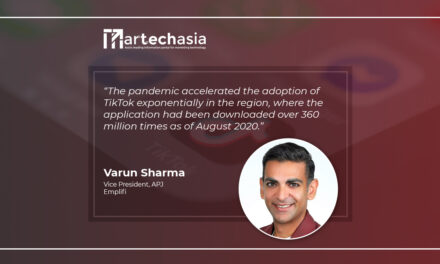In this interview, Jennifer Smith, Chief Marketing Officer at Brightcove, explains why there is a disconnect between brands and their audience and how companies can create a win-win situation for both themselves and their consumers.
Once upon a time, bloggers and social media personalities were viewed as authentic advocates for brands and products and were always the go-to when it came to marketing online. But consumers are now increasingly aware – and wary of – paid-for endorsements.
New research by Brightcove, a leading intelligent video platform, has found that consumers in APAC were least likely to trust video content by an influencer. In contrast, consumers were more than three times as likely to trust video content directly from a brand, with videos by other customers coming in second as a trusted source of information.
What’s curious is that businesses are spending more on influencer marketing, with a study in Southeast Asia showing that an increasing number of brands are allocating at least 30% of their marketing budgets for influencer marketing.
We spoke with Jennifer Smith, Chief Marketing Officer at Brightcove, to understand why this disconnect between brands and their audience is happening, and how companies can create a win-win situation for both themselves and their consumers.

There are reports that influencers are still key to marketing in Asia. Is it true? How do you see this?
Once upon a time, bloggers and social media personalities were viewed as authentic advocates for brands and products and were always the go-to when it came to marketing online. This is exactly why they were labelled influencers. Over time though, consumers have become increasingly aware – and wary of – paid-for endorsements and sponsored posts.
What is curious is that businesses are spending more on influencer marketing, with a study in Southeast Asia showing that an increasing number of brands are allocating at least 30% of their marketing budgets to influencer marketing.
Do audiences in Asia trust influencers? What role does video play in establishing trust between a brand and its audience?
According to the new research we’ve done in our ‘Using E-Commerce Video to Drive Sales’ report earlier this year, consumers in Asia-Pacific (APAC) were least likely to trust video content by an influencer. In contrast, consumers in APAC were more than three times as likely to trust video content directly from a brand, with videos by other customers coming in second as a trusted source of information.
When it comes to establishing trust, video is a medium that provides value to people at multiple points during their consumer buying journey. This is why 85% of consumers worldwide have found that videos are essential when shopping online. Videos are easy to consume, increase brand awareness through discovery, help with education through informational videos about the product, and even influence a buyer’s decision-making through video reviews or endorsements. This is why videos are an incredibly powerful tool for businesses to build trust and confidence with their audience and are an essential tool to turn customers into advocates and repeat customers.
How and why is video changing the way brands collaborate and engage with audiences?
As a result of lockdowns and travel restrictions, internet consumption in Southeast Asia rose at a blistering rate, with more than 80 million new users coming online since 2019. As more users shift to digital media and entertainment, streaming and video consumption have increased.
Data from our latest Global Video Index shows that this trend persists; audiences in Asia-Pacific are still watching more videos and spending more time doing so as we emerge from the pandemic – with video views increasing by 13% and time watched up 65%.
Therefore, OTT services are the ideal channel for businesses to reach their audiences across a range of devices as streaming becomes a mainstay in people’s lives.
This is why every organisation must act like a media company to remain competitive. Content is still king, so organisations need to develop content to educate and entertain to ensure retention. This content can then be amplified through their OTT platforms and other owned marketing channels.
However, just creating good videos is not enough – brands also need to be aware of how their content is presented to keep audiences engaged and be aware of where their videos are hosted to avoid content sprawl. This is why tapping on a company like Brightcove and our ability to deliver always-on, multi-device accessibility means audiences will be able to easily find the video they want on a platform that provides a branded experience.
What works best – short-form content or long-form content? What insights can you share on this for marketers?
Both short-form content and long-form content work, but knowing which to pick would depend on a marketer’s objectives.
Short-form video content has been gaining huge traction lately, as evident from the rise of platforms like TikTok and Instagram Reels. This is why short-form videos are more suited for marketing on social media to first capture a user’s attention since these easily consumable pieces of content can be used to succinctly convey key brand messages.
Long-form video can be leveraged successfully as a brand-building tool to increase loyalty and stickiness. This format also works for internal communications and training. By first understanding who their audience is, brands can then produce long-form content that resonates with their audience, evoking psychological responses that align with their brand story. Long-form content can also be used to develop engaging and passionate storylines and can communicate a brand’s ideals succinctly and effectively.
What’s the importance of creating and delivering content in a format that creates long-term engagement while meeting the needs and expectations of an audience?
Today’s audiences crave the same dynamic always-on experience they enjoy with popular streaming services. With that in mind, Brightcove empowers businesses to think and act like media companies. Media companies create content, distribute it, monetize it, and own it from start to finish. Likewise, businesses need to think about visitors to their websites like paid subscribers and need to develop content with the mindset of educating and entertaining so they can keep people engaged.
With Brightcove’s suite of products and solutions, there’s something to suit every objective – from helping marketers to build immersive, web, and mobile-responsive experiences to providing companies with comprehensive data analytics to uncover reasons behind user acquisition, churn, and stickiness.
In turn, organisations gain access to these in-depth video and viewer insights so that businesses can understand who is viewing their content, how it is viewed (devices, browsers, operating systems), how long it is viewed, and where viewers are coming from. Businesses can then use this data to build audience profiles to better understand the kind of content specific audience segments want. Customer experience can thus continually be improved with recommended content catered to each individual’s preferences, driving viewer engagement based on interests, and improving retention.

















